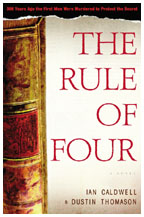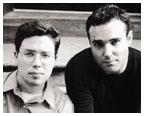July 7, 2004: Reading Room
Ian Caldwell ’98, left, and coauthor Dustin Thomason based their novel on a strange Renaissance text Caldwell studied at Princeton. (Photo: Olivier Delfosse) |
Secret
codes, tunnels, and murder
Ian Caldwell ’98 pens a thriller set at
Princeton
When Ian Caldwell ’98 and his longtime friend Dustin Thomason finished college, they decided to tackle something they had always wanted to do: write a novel. They planned to crank it out in three months, before Caldwell started his job at a software company and before Thomason, a Harvard alumnus, began medical school. They holed up in Caldwell’s parents’ basement in Annandale, Virginia — writing chapters independently, then swapping them for revisions. But by September 1998, there was much more work to do. The Rule of Four, published by Dial Press in May, would take another six years to finish. “If we had thought it was going to take that long, I don’t know that we could have started it,” says Caldwell.
Persevere they did. Caldwell quit his job after a year to write full-time from Newport News, Virginia. He made ends meet by teaching S.A.T. and G.R.E. prep courses at night. Thomason worked on the manuscript while earning an M.D. and M.B.A. from Columbia University. “The pull of this book is something we couldn’t shake,” says Caldwell.
A thriller set on Princeton’s campus, The Rule of Four revolves around The Hypnerotomachia Poliphili, a real, obscure book published anonymously in 1499 in Venice, written in seven languages, and illustrated with bizarre woodcuts. The Rule of Four’s main characters, Princeton seniors Tom Sullivan and Paul Harris, try to unravel a secret message encoded in the strange Renaissance text.
 The
Rule of Four has been compared to Dan Brown’s bestseller, The
Da Vinci Code (2003). Publishers Weekly called The Rule of Four
the “more cerebral — and better written — of the two.”
The
Rule of Four has been compared to Dan Brown’s bestseller, The
Da Vinci Code (2003). Publishers Weekly called The Rule of Four
the “more cerebral — and better written — of the two.”
Caldwell and Thomason owe the idea for the novel’s mystery to history professor Anthony Grafton and his seminar, “Renaissance Art, Science, and Magic,” which Caldwell took senior year. Grafton suggested Caldwell write his final paper on The Hypnerotomachia Poliphili. “I said, ‘How do you spell that?’” recalls Caldwell.
The Hypnerotomachia Poliphili, says Caldwell, is, on the surface, about Poliphilo, who searches for the woman he loves. But the author takes many detours, for example, describing in detail the measurements of buildings. The book “just doesn’t make sense,” says Caldwell, whose senior thesis for the history department was on French politics in the 1930s. “The pieces don’t all come together.”
In The Rule of Four, the pieces do come together, but not before two people are knocked off, and Sullivan and Harris become obsessed with the Renaissance text. Sullivan, the novel’s narrator, describes life at Princeton — eating clubs, college pranks, and the coming-of-age of young men. The novel looks at the bonds of friendship and how relationships change, and sometimes dissolve, over time.
The authors, whose first collaborative writing effort was a third-grade
play, set the story at Princeton because of the feel of the insular campus,
says Caldwell. He remembers late, misty nights, working on papers: “Walking
through the Gothic buildings toward the Wawa to get a drink, you could
see shadows passing in the distance — that was exactly the mood
we wanted for this book.” ![]()
By K.F.G.
BOOK SHORTS
 Ultimate Style:
The Best of the Best Dressed List — Bettina Zilkha ’82
(Assouline). Founded in 1940 by Eleanor Lambert as a publicity ploy to
boost the drooping American fashion industry, the annual Best Dressed
List includes famous women considered fashion icons of their times —
Grace Kelly, Audrey Hepburn, Bianca Jagger, and more recently Gwyneth
Paltrow. Zilkha features four to six of the most stylish women from each
decade in this coffee-table book. Zilkha is the international contributing
editor for TheTrendReport.com.
Ultimate Style:
The Best of the Best Dressed List — Bettina Zilkha ’82
(Assouline). Founded in 1940 by Eleanor Lambert as a publicity ploy to
boost the drooping American fashion industry, the annual Best Dressed
List includes famous women considered fashion icons of their times —
Grace Kelly, Audrey Hepburn, Bianca Jagger, and more recently Gwyneth
Paltrow. Zilkha features four to six of the most stylish women from each
decade in this coffee-table book. Zilkha is the international contributing
editor for TheTrendReport.com.
 Window Seat:
Reading the Landscape from the Air — Gregory Dicum ’91
(Chronicle Books). Illustrated with more than 70 aerial photographs, this
book helps travelers learn how to “read” the landscape as
they fly over North America at 35,000 feet. Dicum divides the land into
regions and describes the landforms, waterways, cities, and major sights
travelers will see from their windows. Dicum also wrote The Coffee
Book (1999).
Window Seat:
Reading the Landscape from the Air — Gregory Dicum ’91
(Chronicle Books). Illustrated with more than 70 aerial photographs, this
book helps travelers learn how to “read” the landscape as
they fly over North America at 35,000 feet. Dicum divides the land into
regions and describes the landforms, waterways, cities, and major sights
travelers will see from their windows. Dicum also wrote The Coffee
Book (1999).
 Re-Enchantment:
Tibetan Buddhism Comes to the West — Jeffery Paine *71
(Norton). The author explores the dramatic growth of Tibetan Buddhism
in the West and how that religion has changed the American religious landscape.
Paine recounts stories of people who have been involved in this movement,
such as Jetsunma, the first Western woman to be recognized as a reincarnated
Buddhist figure. Paine was the literary editor of the Wilson Quarterly.
Re-Enchantment:
Tibetan Buddhism Comes to the West — Jeffery Paine *71
(Norton). The author explores the dramatic growth of Tibetan Buddhism
in the West and how that religion has changed the American religious landscape.
Paine recounts stories of people who have been involved in this movement,
such as Jetsunma, the first Western woman to be recognized as a reincarnated
Buddhist figure. Paine was the literary editor of the Wilson Quarterly.
![]()
By K.F.G.

